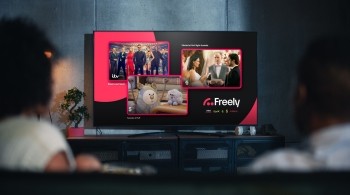Need help looking for the right size TV? While we all can admit, a bigger TV gives you the cinematic feel that instantly wows you, it might not be the best thing for your room, or where you're looking to position your TV.

But, not to worry, this guide will help you choose the best TV size for you to have the most comfortable viewing experience, and, if you’re still stuck, make sure to read up on the difference between Mini LED, OLED, QLED and UHD! Now to address the big decision, what size should you go for, and how far away should my TV be?
How to measure your TV
It seems like nowadays TVs are only getting bigger, and this almost makes it harder to figure out what size TV you should look to get. You don’t want it to absorb the room, but you also don’t want the TV to feel far away. So, what’s the first step you should take? Well, we suggest measuring the size of the TV you currently have, to help you compare to those slightly larger, or smaller sizes available on the market. TV sizes are measured diagonally, from the upper left corner of the screen to the lower right corner, so, grab the tape measure and be sure to make a note in inches!
Calculating your viewing distance
Finding the right viewing distance can vary depending on a few things, screen size, resolution, how well your eyes work to name a few! But hopefully this helps in taking that next step in choosing the perfect TV size.
You’ll probably find the closer you are to your TV the more the pixels in the screen become more noticeable, but with today’s technology and with 4K technology this is becoming much less of an issue. This means you can usually get away with having a bigger TV screen in a smaller room without any pesky pixels standing out! A bigger TV screen elevates your viewing experience. Higher picture quality creates a more immersive atmosphere, making movie nights with family, action-packed shows, and even major sporting events all the more unforgettable.
The human eye takes in a visual of around 180 degrees, but did you know your central vision is only a third of that? When watching your TV, we’d suggest that it fills about 30-40 degrees of your vision so that you’re able to take in the whole screen without being overwhelmed.
Ideal distance for 4K TVs
| TV Size (inches) | Distance |
|---|---|
| 42 | 1.28m |
| 43 | 1.32m |
| 46 | 1.4m |
| 50 | 1.52m |
| 55 | 1.68m |
| 65 | 1.98m |
| 75 | 2.29m |
Ideal distance for Full HD TVs
| TV Size (inches) | Distance |
|---|---|
| 32 | 1.65m |
| 40 | 2m |
| 42 | 2.15m |
| 43 | 2.2m |
| 50 | 2.55m |
| 55 | 2.8m |
It’s important to note that now the most popular TV size is between 48 to 55 inches. In the realm of premium 4K OLED TVs, the smallest panel size traditionally available was 55 inches. However, in recent years, options have expanded to include 48-inch and even 42-inch models. In contrast, backlit TVs such as QLED or LCD offer a wider range of sizes, but those smaller than 43 inches typically feature Full HD rather than 4K resolution. While 85 inches is a standard 'large' screen size, there are occasional offerings of 98-inch and 100-inch models. As for 8K TVs, the smallest available size starts at 55 inches, with the largest extending up to 98 inches.
Despite all these measurements, it’s important to consider what the room is like that you want to put the TV in. Remember these are only guidelines! You may want the space to feel slightly cosier so you have the TV a little closer to you, or you may want it to be further away as to not take up as much space for other furniture.
Check out our other buying advice and tech guides to help you find the right TV for you and elevate your viewing experience!



